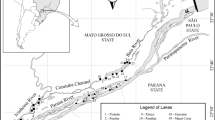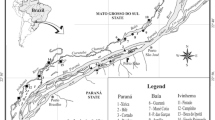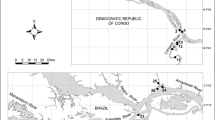Abstract
Large river floodplains are convenient model systems to test for variation in animal and plant community structure, as they have a variety of habitats and substrates and are generally dynamic systems through the occurrence of flood pulses with varying intensity. South American floodplain systems furthermore have unique types of substrates, in the form of root systems of floating macrophytes. Here, we investigate the variation in ostracod (small, bivalved crustaceans) communities in relation to substrates and related environmental variables. Sampling was effected in 2004 in the alluvial valley of the upper Paraná River, Brazil, in the wet and dry seasons. Five different substrates, including littoral sediment and four macrophyte species root and leaf systems, in four hydrological systems and a variety of habitat types, were sampled. Fifty-four species of Ostracoda were found. Variation partitioning analysis (RDA) showed that ostracod communities significantly differed between different substrates, mainly between the littoral and plants with small root systems (Eichhornia azurea) on the one hand, and plants with large and complex root systems on the other hand (Eichhornia crassipes and Pistia stratiotes). RDA analyses indicated that the pleuston (biotic communities associated with root systems of floating plants) of E. crassipes comprised more non-swimming species than the pleuston of the smaller roots of P. stratiotes, but species-level Kruskal–Wallis analyses could not detect significant differences between both macrophyte species. Also habitat type and hydrological systems contributed to variation amongst ostracod communities, but less so than the factor substrate. Abiotic factors also contributed to variation, but the ranges of all measured water chemistry variables were narrow. This uniformity in abiotic factors, which might be owing to the occurrence of large flooding events, unites all water bodies, even those that are generally separated.








Similar content being viewed by others
References
Agostinho, A. A. & M. Zalewski, 1996. A planície alagável do alto rio Paraná: importância e preservação (Upper Paraná River Floodplain: Importance and Preservation). EDUEM, Maringá.
Agostinho, A. A., H. F. Julio Jr. & M. Petrere Jr., 1994. Itaipu reservoir (Brazil): impacts of the impoundment on the fish fauna and fisheries. In Cowx, I. G. (ed.), Rehabilitation of Freshwater Fisheries. Bodman, Fishing News Book, Oxford: 171–184.
Agostinho, A. A., L. M. Bini, L. C. Gomes, H. F. Júlio Jr., C. S. Pavanelli & C. S. Agostinho, 2004. Fish assemblages. In Thomaz, S. M., A. A. Agostinho & N. S. Hahn (eds), The Upper Paraná River and its Floodplain: Physical Aspects. Ecology and Conservation. Backhuys Publishers, Leiden: 223–246.
Albertoni, E. F. & N. L. Würdig, 1996. Comunidade de ostracodes associada à macrófitas aquáticas na lagoa do Gentil, Tramandaí, RS. Acta Limnologica Brasiliensis 8: 103–114.
Barreto, R., R. Charudattan, A. Pomella & R. Hanada, 2000. Biological control of neotropical aquatic weeds with fungi. Crop Protection 19: 697–703.
Bode, S. N. S., S. Adolfsson, D. K. Lamatsch, E. R. D. Bautz, M. J. F. Martins, O. Schmit, J. Vandekerkhove, F. Mezquita, T. Namiotko, G. Rossetti, I. Schön, R. K. Butlin & K. Martens, 2009. Exceptional cryptic diversity and multiple origins of parthenogenesis in a freshwater ostracod. Molecular Phylogenetics and Evolution 54: 542–552.
Boschilia, S. M., E. F. Oliveira & S. M. Thomaz, 2008. Do aquatic macrophytes co-occur randomly? An analysis of null models in a tropical floodplain. Oecologia 156: 203–214.
Botts, P. S. & B. C. Cowell, 1993. Temporal patterns of abundance of epiphytic invertebrates on Typha shoots in a subtropical lake. Journal of the North American Benthological Society 12: 27–39.
Bunbury, J. & K. Gajewski, 2005. Quantitative analysis of freshwater ostracode assemblages in southwestern Yukon Territory, Canada. Hydrobiologia 545: 117–128.
Center, T. D., T. K. Van, F. A. Dray Jr., S. J. Franks, M. T. Rebelo, P. D. Pratt & M. B. Rayamajhi, 2005. Herbivory alters competitive interactions between two invasive aquatic plants. Biological Control 33: 173–185.
Coetzee, J., M. Byrne & M. Hill, 2003. Failure of Eccritotarsus catarinensis, a biological control agent of waterhyacinth, to persist on pickerelweed, a non-target host in South Africa, after forced establishment. Biological Control 28: 229–236.
Cyr, H. & J. A. Downing, 1988. The abundance of phytophilous invertebrates on different species of submerged macrophytes. Freshwater Biology 20: 365–374.
De Deckker, P., 1977. The distribution of the “giant” ostracods (Family: Cyprididae, Baird, 1845) endemic to Australia. In Löffler, H. & D. L. Danielopol (eds), Aspects of Ecology and Zoogeography of Recent and Fossil Ostracoda. Junk, The Hague: 285–294.
Declerck, S., M. Vanderstukken, A. Pals, K. Muylaert & L. de Meester, 2007. Plankton biodiversity along a gradient of productivity and its mediation by macrophytes. Ecology 88: 2199–2210.
Esteves, F. A., 1998. Fundamentos de Limnologia. Interciência, Rio de Janeiro.
Higuti, J., 2004. Composition, density and habitats of benthic chironomid larvae. In Thomaz, S. M., A. A. Agostinho & N. S. Hahn (eds), The Upper Paraná River and its Floodplain: Physical Aspects. Ecology and Conservation. Backhuys Publishers, Leiden: 209–221.
Higuti, J., L. F. M. Velho, F. A. Lansac-Tôha & K. Martens, 2007. Pleuston communities are buffered from regional flood pulses: the example of ostracods in the Paraná River floodplain, Brazil. Freshwater Biology 52: 1930–1943.
Higuti, J., C. Meisch & K. Martens, 2009a. On Paranacypris samambaiensis n.gen. n.sp. (Crustacea, Ostracoda), the first South American psychrodromid, from the alluvial valley of the Upper Paraná River, Brazil. Journal of Natural History 43: 769–783.
Higuti, J., F. A. Lansac-Tôha, L. F. M. Velho & K. Martens, 2009b. Biodiversity of non-marine ostracods (Crustacea, Ostracoda) in the alluvial valley of the upper Paraná River, Brazil. Brazilian Journal of Biology 69(2 suppl): 661–668.
Higuti, J., F. A. Lansac-Tôha, L. F. M. Velho, R. L. Pinto, L. C. G. Vieira & K. Martens, 2009c. Composition and distribution of Darwinulidae (Crustacea, Ostracoda) in the alluvial valley of the upper Paraná River, Brazil. Brazilian Journal of Biology 69(2): 253–262.
Horne, D. J. & K. Martens, 1998. An assessment of the importance of resting eggs for the evolutionary success of Mesozoic non-marine cypridoidean Ostracoda (Crustacea). Advances in Limnology 52: 549–561.
Iversen, T. M., J. Thorup, T. Hansen, J. Lodal & J. Olsen, 1985. Quantitative estimates and community structure of invertebrates in a macrophyte rich stream. Archiv für Hydrobiologie 102: 291–301.
Jin, Z. H., Y. Y. Zhuang, S. G. Dai & T. L. Li, 2003. Isolation and identification of extracts of Eichhornia crassipes and their allelopathic effects on algae. Bulletin of Environmental Contamination Toxicology 71: 1048–1052.
Junk, W. J., P. B. Bayley & R. E. Sparks, 1989. The flood pulse concept in river-floodplain systems. In Dodge, D. P. (ed.), Proceedings of the International Large River Symposium (LARS). Canadian Special Publication of Fisheries and Aquatic Sciences, Otawa: 110–127.
Justus, J. O., 1985. Subsídios para a interpretação morfogenética através da utilização de imagens de radar. Master Thesis, Universidade Federal da Bahia: 204 pp.
Kiss, A., 2007. Factors affecting spatial and temporal distribution of Ostracoda assemblages in different macrophyte habitats of a shallow lake (Lake Fehér, Hungary). Hydrobiologia 585: 89–98.
Lansac-Tôha, F. A., C. C. Bonecker & L. F. M. Velho, 2004. Composition, species richness and abundance of the zooplankton community. In Thomaz, S. M., A. A. Agostinho & N. S. Hahn (eds), The Upper Paraná River and its Floodplain: Physical Aspects. Ecology and Conservation. Backhuys Publishers, Leiden: 145–190.
Legendre, P. & P. Legendre, 1998. Numerical Ecology. Developments in Environmental Modelling, Vol. 20. Elsevier, The Netherlands.
Lepš, J. & P. Šmilauer, 2003. Multivariate Analysis of Ecological Data Using CANOCO. Cambridge University Press, Cambridge.
Lopez, L. C. S., D. A. Gonçalves, A. Mantovani & R. I. Rios, 2002. Bromeliad ostracods pass through amphibian (Scinaxax perpusillus) and mammalian guts alive. Hydrobiologia 485: 209–211.
Martens, K. & F. Behen, 1994. A checklist of the non-marine ostracods (Crustacea, Ostracoda) from the inland waters of South America and adjacent islands. Travaux Scientifiques du Musée d’ Histoire Naturelle de Luxembourg 22: 1–81.
Martens, K., N. L. Würdig & F. Behen, 1998. Maxillopoda. Non-marine Ostracoda. In Young, P. S. (ed.), Catalogue of Crustacea of Brazil. Museu Nacional, Rio de Janeiro: 45–65.
Martens, K., I. Schön, C. Meisch & D. J. Horne, 2008. Global biodiversity of non-marine Ostracoda (Crustacea). Hydrobiologia 595: 185–193.
McKenzie, K. G., 1971. Paleozoogeography of freshwater Ostracoda. Bulletin du Centre de Recherchers de Pau 5: 207–237.
Meisch, C., 2000. Freshwater Ostracoda of Western and Central Europe. Spektrum Akademischer Verlag GmbH, Heidelberg, Berlin.
Mezquita, F., H. I. Griffiths, M. I. Dominguez & M. A. Lozano-Quilis, 2001. Ostracoda (Crustacea) as ecological indicators: a case study from Iberian Mediterranean brooks. Archiv für Hydrobiologie 150: 545–560.
Mischke, S., U. Herzschuh, G. Massmann & C. Zhang, 2007. An ostracod-conductivity transfer function for Tibetan lakes. Journal of Paleolimnology 38: 509–524.
Mourguiart, P. & P. Carbonel, 1994. A quantitative method of palaeolake-level reconstruction using ostracod assemblages: an example from the Bolivian Altiplano. Hydrobiologia 288: 183–193.
Neiff, J. J., 1990. Ideas para la interpretacion ecológica del Paraná. Interciencia 15: 424–441.
Ogutu-Ohwayo, R., R. E. Hecky, A. S. Cohen & L. Kaufman, 1997. Human impacts on the African Great Lakes. Environmental Biology of Fishes 50: 117–131.
Oliveira, M. D. & D. F. Calheiros, 2000. Flood pulse influence on phytoplankton communities of the south Pantanal floodplain, Brazil. Hydrobiologia 427: 101–112.
Pinto, R. L., C. E. F. Rocha & K. Martens, 2003. On two new species of the genus Vestalenula Rossetti & Martens, 1998 (Crustacea, Ostracoda, Darwinulidae) from semi-terrestrial habitats in São Paulo State (Brazil). Zoological Journal of the Linnean Society 139: 305–313.
Pinto, R. L., C. E. F. Rocha & K. Martens, 2004. On the genus Penthesilenula Rossetti & Martens, 1998 (Crustacea, Ostracoda, Darwinulidae) from (semi-) terrestrial habitats in São Paulo State (Brazil), with the description of a new species. Journal of Natural History 38: 2567–2589.
Pinto, R. L., C. E. F. Rocha & K. Martens, 2005a. On the evolution of the genus Microdarwinula Danielopol, 1968 (Ostracoda, Darwinulidae) with the description of a new species from semi-terrestrial habitats in São Paulo State (Brazil). Crustaceana 78: 975–986.
Pinto, R. L., C. E. F. Rocha & K. Martens, 2005b. On new terrestrial ostracods (Crustacea, Ostracoda) from Brazil, primarily from São Paulo State. Zoological Journal of the Linnean Society 145: 145–173.
Pinto, R. L., C. E. F. Rocha & K. Martens, 2008. On the first terrestrial ostracod of the Superfamily Cytheroidea (Crustacea, Ostracoda): description of Intrepidocythere ibipora n. gen. n. sp. from the forest leaf litter in São Paulo State, Brazil. Zootaxa 1828: 29–42.
Pires-Neto, A. G., A. Bartorelli & M. S. Vargas, 1994. A planície do rio Paraná. Boletim Paranaense de Geociências 42: 217–229.
Por, F. D., 1995. The Pantanal of Mato Grosso, World’s Largest Wetland. Kluwer Academic Publishers, Dordrecht.
Por, F. D. & C. E. F. Rocha, 1998. The Pleustal, a third limnic biochore and its neotropical centre. Internationale Vereinigung füer Theoretische und Angewandte Limnologie Verhandlungen 26: 1876–1881.
Rainwater, F. H. & L. L. Thatcher, 1960. Methods for Collection and Analysis a Water Samples. United States Government Printing Office, Washington.
Rossetti, G. & K. Martens, 1996. Redescription and morphological variability of Darwinula stevensoni (Brady & Robertson, 1870) (Crustacea, Ostracoda). Bulletin van het Koninklijk Belgisch Instituut voor Natuurwetenschappen, Biologie 66: 73–92.
Rossetti, G. & K. Martens, 1998. Taxonomic revision of the Recent and Holocene representatives of the Family Darwinulidae (Crustacea, Ostracoda), with a description of three new genera. Bulletin de L′Institut Royal des Sciences Naturelles de Belgique, Biologie 68: 55–110.
Sandberg, P. A. & P. L. Plusquellec, 1974. Notes on the anatomy and passive dispersal of Cyprideis (Cytheracea, Ostracoda). Geocience and Man 6: 1–26.
Savatenalinton, S. & K. Martens, 2009. Generic revision of Cypricercinae McKenzie, 1971 (Crustacea, Ostracoda), with the description of three new genera and one new species and a phylogenetic analysis of the subfamily. Hydrobiologia 632: 1–48.
Souza, H. B. & J. C. Derisio, 1977. Guia técnico de coleta de amostras de água. Companhia de Tecnologia de Saneamento Ambiental – CETESB, São Paulo.
Souza Filho, E. E. & J. C. Stevaux, 2004. Geology and geomorphology of the Baía-Curutuba-Ivinheima River complex. In Thomaz, S. M., A. A. Agostinho & N. S. Hahn (eds), The Upper Paraná River and its Floodplain: Physical Aspects. Ecology and Conservation. Backhuys Publishers, Leiden: 1–29.
Stevaux, J. C., E. E. Souza-Filho, S. Medeanic & G. Yamskikh, 2004. The quaternary history of the Paraná River and its floodplain. In Thomaz, S. M., A. A. Agostinho & N. S. Hahn (eds), The Upper Paraná River and Its Floodplain: Physical Aspects, Ecology and Conservation. Backhuys Publishers, Leiden: 31–53.
Taniguchi, H. & M. Tokeshi, 2004. Effects of habitat complexity on benthic assemblages in a variable environment. Freshwater Biology 49: 1164–1178.
Taniguchi, H., S. Takano & M. Tokeshi, 2003. Influences of habitat complexity on the diversity and abundance of epiphytic invertebrates on plants. Freshwater Biology 48: 718–728.
Thomaz, S. M., L. M. Bini, T. A. Pagioro, K. J. Murphy, A. M. Santos & D. C. Souza, 2004a. Aquatic macrophytes: diversity, biomass and decomposition. In Thomaz, S. M., A. A. Agostinho & N. S. Hahn (eds), The Upper Paraná River and its Floodplain: Physical Aspects. Ecology and Conservation. Backhuys Publishers, Leiden: 331–352.
Thomaz, S. M., T. A. Pagioro, L. M. Bini, M. C. Roberto & R. R. A. Rocha, 2004b. Limnological characterization of the aquatic environments and the influence of hydrometric levels. In Thomaz, S. M., A. A. Agostinho & N. S. Hahn (eds), The Upper Paraná River and its Floodplain: Physical Aspects. Ecology and Conservation. Backhuys Publishers, Leiden: 75–102.
Thomaz, S. M., A. A. Agostinho & N. S. Hahn (eds), 2004c. The Upper Paraná River and its Floodplain: Physical Aspects, Ecology and Conservation. Backhuys Publishers, Leiden: 393 pp.
Thomaz, S. M., L. M. Bini & R. L. Bozelli, 2007. Floods increase similarity among aquatic habitats in river-floodplain systems. Hydrobiologia 579: 1–13.
Thomaz, S. M., E. D. Dibble, L. R. Evangelista, J. Higuti & L. M. Bini, 2008. Influence of aquatic macrophyte habitat complexity on invertebrates abundance and richness in tropical lagoons. Freshwater Biology 53: 358–367.
Train, S. & L. C. Rodrigues, 2004. Phytoplanktonic assemblages. In Thomaz, S. M., A. A. Agostinho & N. S. Hahn (eds), The Upper Paraná River and its Floodplain: Physical Aspects. Ecology and Conservation. Backhuys Publishers, Leiden: 103–124.
Twombly, S. & W. M. Lewis Jr., 1987. Zooplankton abundance and species composition in Laguna la Orsinera, a Venezuelan floodplain lake. Archiv für Hydrobiologie 1: 87–107.
Twombly, S. & W. M. Lewis Jr., 1989. Factors regulating cladoceran dynamics in a Venezuelan floodplain lake. Journal of Plankton Research 11: 317–333.
Van der Meeren, T., J. E. Almendinger, E. Ito & K. Martens, 2010. The ecology of ostracodes (Ostracoda; Crustacea) in western Mongolia. Hydrobiologia 641:253–273.
Viehberg, F. A., 2006. Freshwater ostracod assemblages and their relationship to environmental variables in waters from northeast Germany. Hydrobiologia 571: 213–224.
Wagner, R., 1976. Sampling and sample preparation water. Fresenius Zeitschrift fuer Analytische Chemie 228: 315–321.
Würdig, N. L. & S. M. F. Freitas, 1988. Distribuição espacial e temporal da comunidade de ostrácodes na lagoa emboaba, Rio Grande do Sul, Brasil. Acta Limnologica Brasiliensis 2: 677–700.
Würdig, N. L. & I. D. Pinto, 2001. Pseudocandona pumilis sp. nov. (Ostracoda). Ecological data and distribution in the Tramandai lagunar system, RS, Southern Brasil. Nauplius 7: 39–51.
Acknowledgments
Julien Cillis (Brussels, Belgium) offered technical assistance with the scanning electron micrographs. Mrs Sukonthip Savatenalinton (University of Ghent, Belgium) assisted the first author in many laboratorial activities; Dr. Ricardo Lourenço Pinto (University of São Paulo) assisted in the field sampling. Several researchers of the Laboratory of Limnology of Nupélia helped with the measurements of abiotic variables; Dirceu Galli (University of Maringá) assisted with the Ca and Mg analyses. Jaime Luiz Lopes Pereira (Nupélia, University of Maringá) assisted in the production of the map and the plates. This project was supported by CNPq (proc. 472434/03-9 and through the Long-Term Ecological Research (LTER) Program) and Nupélia. S.A.J.D. is a postdoctoral fellow with the Research Foundation—Flanders (FWO-Vlaanderen). The Royal Belgian Institute of Natural Sciences financed several trips of KM to Maringá.
Author information
Authors and Affiliations
Corresponding author
Additional information
Handling editor: B. Oertli
Electronic supplementary material
Below is the link to the electronic supplementary material.
Rights and permissions
About this article
Cite this article
Higuti, J., Declerck, S.A.J., Lansac-Tôha, F.A. et al. Variation in ostracod (Crustacea, Ostracoda) communities in the alluvial valley of the upper Paraná River (Brazil) in relation to substrate. Hydrobiologia 644, 261–278 (2010). https://doi.org/10.1007/s10750-010-0122-1
Received:
Revised:
Accepted:
Published:
Issue Date:
DOI: https://doi.org/10.1007/s10750-010-0122-1




